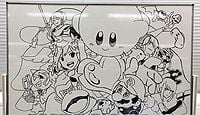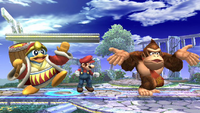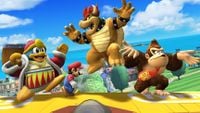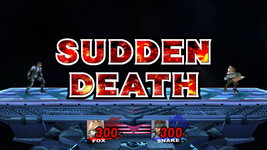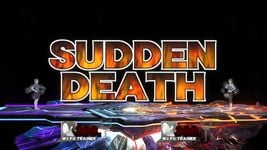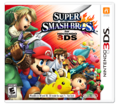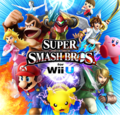Super Smash Bros. 4
| Super Smash Bros. 4 (unofficial title) | |
|---|---|
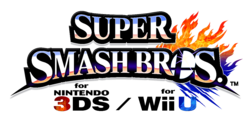 Collective logo for the game. | |
| Developer(s) | Bandai Namco Sora Ltd. |
| Publisher(s) | Nintendo |
| Designer(s) | Masahiro Sakurai |
| Engine | Havok |
| Released | Nintendo 3DS September 13, 2014 October 2, 2014 October 3, 2014 October 4, 2014 July 24, 2015 September 10, 2015 Wii U |
| Genre(s) | Fighting |
| Mode(s) | Single player, Multiplayer, Online multiplayer |
| Ratings | CERO: A ESRB: E10+[1] OFLC: PG[2] PEGI: 12+ (provisional) |
Super Smash Bros. 4 (also referred to by shorthands such as Smash 4, SSB4, or more informally Sm4sh, and officially as Super Smash Bros. for Nintendo 3DS/Wii U) is a term used to collectively refer to Super Smash Bros. for Nintendo 3DS and Super Smash Bros. for Wii U, two games in the Super Smash Bros. series created by Bandai Namco[3] and Sora Ltd. However, in an interview with Kotaku, Masahiro Sakurai has stated he considers the 3DS version the fourth installment and the Wii U version the fifth installment. The games feature mostly identical gameplay, but with several differences in other areas. The 3DS version is the first game of the series to be released on a handheld.
The 3DS version launched in Japan on September 13th, 2014 and in most other parts of the world on October 3rd, 2014. The 3DS version was released in stores one day earlier in Germany on October 2nd, 2014 to avoid coinciding with German Unity Day, and was released one day later in Australia on October 4th, 2014 because of time zone differences. Hong Kong and Taiwan received a release of the game over 10 months later, on July 24th, 2015, while South Korea got its release on September 10th, 2015, nearly a full year after the game's initial launch in Japan. The Wii U version was released in North America on November 21st, 2014, and was released on November 28th, 2014 in Europe, November 29th, 2014 in Australia, and on December 6th, 2014 in Japan.
Both versions received positive reviews; critics applauded the fine-tuning of existing gameplay elements but criticized some issues with online play. Both versions sold quickly, with the 3DS version selling over 7.92 million copies worldwide as of February 2016, and the Wii U version selling over 4.61 million copies during the same time period.
Characters
Both games feature identical character rosters. The roster contains a total of 58 characters, 34 of which return from Brawl, 3 of which return after being cut in the transition from Melee to Brawl (Dr. Mario, Mewtwo, and Roy), and 21 of which are new to the series. Of these 58, 39 are starter characters in both versions and 8 are unlockable characters in both versions, while 4 characters are unlockable in the 3DS version but starters in the Wii U version. Additionally, 7 characters appear as downloadable content. A further 8 "characters" exist as alternate costumes for other preexisting characters, Alph as a palette swap of Olimar, and each of the seven Koopalings as palette swaps of Bowser Jr..
Stages
The two games feature considerably different stage selections, which is one of the primary differences between the two games. The 3DS version features a total of 42 stages with 7 unlockable stages and 8 DLC stages, 30 of which are new and 12 of which are familiar. The Wii U version features a total of 55 stages with 6 unlockable stages and 9 DLC stages, consisting of 34 new stages and 21 familiar ones. Only 13 stages are shared between the two versions.
In general, the 3DS version features more stages based on handheld console games, while the Wii U version features more stages based on home console games. However, several stages in both games ignore this distinction.
Past Stages in both games are now known as "Familiar Stages". Three DLC Familiar Stages are shared between the two games.
3DS version
Bold denotes unlockable stages.
Wii U version
Bold denotes unlockable stages.
Modes
Multiplayer
- VS Mode
- 8-Player Smash (Wii U exclusive): In this mode, up to eight players can play in Smash battles, compared to the standard limit of four. Due to system resources, some stages have their behavior modified while in this mode, while other stages cannot be used at all.
- Special Smash (Wii U exclusive): The successor to Special Brawl, in this mode players can create custom battles by changing a variety of options, such as making all the fighters metal. Up to 4 players can play in this mode. This mode does not affect records and stats.
- Smash Run (3DS exclusive): In this mode, up to 4 players have 5 minutes to traverse a large dungeon-like environment, collecting various power-ups and facing enemies from various games. After the time limit, the players fight in a battle utilizing their boosted powers, and can then do subsequent matches with those power-ups. Sakurai mentioned in the April 2014 Nintendo Direct video that this mode was inspired by Kirby Air Ride's City Trial mode, which has a similar premise.
- Players are also able to have items set to their characters via character customization.
- Smash Tour (Wii U exclusive): Players take control of Miis moving along a game board, collecting characters and power-ups in order to win the final match, with each fighter collected acting as one stock.
- Tournament Mode (Wii U exclusive): A competitive elimination mode returning from Melee and Brawl, which was released as a downloadable online feature.
Single Player
- Classic Mode
- All-Star Mode
- Home-Run Contest
- Trophy Rush
- Target Blast
- Multi-Man Mode
- Training Mode
- StreetSmash (3DS exclusive)
- Event Mode (Wii U exclusive)
- Special Orders (Wii U exclusive)
- Trophy Box (Wii U exclusive)
Development
SSB4 was announced in passing at E3 2011; however, the game's development was not slated to begin until sometime after October 2011, after the completion of Sakurai's other project, Kid Icarus: Uprising.[4] He had stated, in response to a fan asking him about whether a "child Link" would appear in the game, that he had not at the time decided on who would appear in the game. However, he had also said that he "can't say that it's entirely out of the realm of possibility that some Capcom character could appear in the next Smash Bros."[5] Indeed, Capcom's Mega Man was ultimately confirmed as playable, and Ryu was made available as DLC. The paired versions of the game were officially revealed at E3 2013 in the form of a trailer on June 11, 2013, with a projected release in 2014.
Development of the game began in early 2012[6], but it went unmentioned during E3 2012, something which many fans were disappointed about despite the known extremely early state of the game; the "first step of the process" was taken shortly after in mid-June. Sakurai expressed disappointment that fans would be waiting for longer than expected for the game to be released due to the earliness of the initial announcement.[7] Shortly afterward, it was revealed during a Nintendo Direct that Namco Bandai (as Bandai Namco was previously named) was the primary developer alongside Sora Ltd., and had already completed a working prototype.[3]
On July 2nd, 2012, Sakurai posted a whiteboard drawing on Twitter which was drawn by the game's staff. It depicts Donkey Kong, Fox, a Heart Container, Kirby, Link, Luigi, Mario, Marth, Meta Knight, Mr. Game & Watch, a Mr. Saturn, Pikachu, a Pikmin, Pit, Sandbag, Wario, and Zero Suit Samus; some argue that the curved lines in the background form the shape of Master Hand. The sketch also has what appears to be large block letters hidden below the visible area. While the post came with no explicit confirmation of any of these characters or elements as reappearing, it did show that they were in some sense acknowledged by the staff; everything depicted would in fact turn out to appear in the final game. The image itself was later removed from the original Twitter post.[8]
Sakurai had remarked that one feature of the 3DS Smash Bros. title would be that players can improve their character through battles and rewards, then transfer them to the Wii U Smash title to play against friends; such a function was ultimately made possible through character customization. He also said the 3DS title was intended to offer a new experience for veteran Smash Bros. fans, and that neither the 3DS game nor the Wii U game would simply be sequels like Melee and Brawl were, and that they would do more than just add characters and stages. It had also been revealed that they were looking towards co-operative play for the Wii U title. Official Nintendo Magazine said "there is merit in having skilled and unskilled players play together, so one emphasis will be on elements of players helping one-another". They also stated that the graphics would be significantly stepped up, as the Wii U can handle high quality graphics, dynamic effects and smooth character movements in HD at 60 frames per second.[9] Sakurai was also quoted as claiming that the new game was unlikely to emphasize new playable characters, focusing instead on gameplay balance and distinctiveness of its characters. [10] Indeed, SSB4 initially introduced less newcomers than Brawl did.
Shortly after the initial E3 2013 trailers, Sakurai said there would be a single-player story mode included in the new Smash Bros.[11], but that it would be different from Brawl's Subspace Emissary in that there would be no cutscenes, since he did not want said cutscenes to be uploaded to the Internet. However, he would later recant this, and announce that he decided to cut any sort of story mode altogether [12].
Sakurai had stated that there were no plans to implement downloadable content or touch screen controls of any variety. However, he also stated that once the game was released DLC was something they would take into consideration. [13] Downloadable content was eventually implemented through several additional fighters, stages, and costumes for Mii Fighters.
Changes from Brawl
Gameplay changes
- The size differences between bigger and smaller characters is somewhat more drastic, which can be seen when comparing the pictures on the right, with Sakurai remarking "A group shot of the big guys. How much bigger are they compared to Mario?" for the latter image.[14] This is most noticeable with Bowser, who now stands much taller than Mario as opposed to being only slightly taller than him in Melee/Brawl.
- In contrast, the range differences between characters are somewhat reduced. Melee-oriented fighters, like Diddy Kong, had their range increased as seen with their more exaggerated attack animations, while characters with weapons, such as Marth, had their ranged reduced either directly with shorter weapons or indirectly as a result of the other characters' range buffs.
- The movesets and animations of returning characters went through a larger amount of change than the returning characters did from the transition of Melee to Brawl, with many returning characters having completely new moves, and some characters being significantly altered (such as with Bowser).
- Many newcomers have several standard attacks that consist of projectiles, a distinction previously held only by Snake in his debut in Brawl. Previously, the vast majority of projectiles were limited to characters' special moves. A notable example is Mega Man, who has six projectiles in his standard moveset.
- Mid-match character changes, such as Zelda/Sheik's Transform, no longer exist. This means that Zelda and Sheik, along with Samus and Zero Suit Samus, are now completely separate characters that are no longer able to transform to the other. This also means the Pokémon Trainer does not return as a playable character, though Charizard returns as its own stand-alone character. This was mainly due to a combination of 3DS hardware limitations and Sakurai's wish for both versions to contain the same roster of characters.[15]
- The game's speed is between that of Melee and Brawl, in an attempt to appeal to both casual and hardcore gamers. Almost every veteran from Brawl has a faster dashing (with Charizard going from 1.8 to 2.0) and falling speed (with ROB going from 1.2 to 1.6, and Fox from 1.831 to 2.05), and every veteran from Brawl has a higher gravity value (with the exception of Lucas). Comparably, the game is faster and considerably less floaty than Brawl, while Melee continues to surpass both games in terms of movement speed.
- In a similar appeal to both casual and hardcore gamers, there are now two distinct type of With Anyone Wi-Fi modes; one called For Fun which is similar to the previous game's casual-styled Basic Brawl, and one called For Glory, a mode explicitly catered to competitive-styled play.
- Additionally, every stage now has an "Ω Form", where the stage's layout is altered into that of Final Destination. These forms cannot be played on in the For Fun mode, while they are the only forms available in the For Glory mode.
- Fast falling now gives a standard increase of 60% to a character's normal falling speed. In Brawl, fast falling gave a standard 40% increase, and in Melee and 64, it varied depending on the character. The exceptions to this rule are Ryu and Link, who gain a 40% and 90% increase, respectively. Combined with the higher falling speeds, this change makes air-to-ground movement much faster than in Brawl, and some aerials are more effective in a short-hop fast-fall, but it also makes it harder to juggle. Finally, using an aerial while fast falling reverts the character to their normal falling speed, making it less technically demanding to perform certain aerial combos. Overall, fast falling gives a much more drastic increase than in past games, with Fox's fast falling speed now surpassing Falco's normal falling speed in Melee.
- As in Brawl, characters barely conserve momentum from their dash after jumping. Likely as a compensation, many characters have had their air speeds increased (with Sheik going from 0.846 to 1.1). However, the changes are not consistent across the cast, as a few characters have had their air speeds lowered.
- The mechanics of grabbing ledges have undergone an unprecedented overhaul[16]. Most notably, edge-hogging has been removed entirely, as attempting to grab a ledge that someone else has already grabbed onto will now gently remove them from the ledge and "steal" it, a mechanic known as "ledge trumping". This changes the entire edge metagame, with players now having to attack opponents that they have ledge trumped instead of completely stopping their recovery by grabbing the edge, along with making edgeguarding more reliant on stage spikes and meteor smashes. On the other hand, ledge trumping itself can be used as an edgeguard, as it leaves the recovering opponent vulnerable. An additional overhaul is the elimination of most planking stall strategies, as the length of intangibility given by grabbing the ledge is now affected by air time and current damage, and no intangibility at all will be granted if a fighter grabs the ledge twice without touching the ground or being hit (making them more open to edgeguarding). Finally, the difference between fast and slow edge options based on current damage has been removed.
- A new mechanic known as rage has been implemented; this increases the player's base knockback dealt (but not damage dealt) at higher damage percentages, starting at 35% and capping at 150%. This works similar to Lucario's Aura effect, which rewards characters if they survive until high percentages – this is especially beneficial to heavyweights, who can easily survive to high percentages and use rage to full effect. The rage effect is made more visible after 100%, as characters begin emitting steam and flashing red.[17]
- Grabbing an opponent will miss if the opponent has been thrown or has escaped from a grab within the past second. This mechanic mitigates against chain grabs, which were not only possible but readily exploitable in Melee and Brawl. This does not apply to grabs from special moves, however.
- Random tripping from Brawl as a result of tapping the control stick has been removed. However, forced tripping remains, as shown by the return of the banana peel item, and some moves that are not yet strong enough to cause tumble animations still have a chance to trip opponents.
- The effect of stale-move negation on knockback has been drastically reduced, meaning it is no longer as important for players to avoid staling their finishing moves. The effect of staleness on damage dealt has been slightly lessened as well, and staleness is no longer applied to items.
- Directional influence works slightly differently. Holding a horizontal direction on the control stick while being hit can now directly increase or decrease knockback in that direction, not just change the launch angle. Holding a vertical direction on the control stick only changes the launch angle (since patch 1.0.4), as in previous games. These changes indirectly benefit characters with vertical combos and finishers, such as Meta Knight, Bayonetta, Ryu, and Fox.
- The ability to negate hitstun is now only possible after 40 frames for air dodging and 45 frames for aerials, significantly later than Brawl's 13/25 frames. This change makes true combos more prevalent, and many characters who were present in Melee have had their combo abilities largely restored, with Captain Falcon being the most notable example, and this is further aided by the increased falling speeds and gravities. However, with the decreased damage on many moves and fall speeds, gravity increasing vertical knockback, and the continued ability to hitstun cancel, true combos generally do not work at higher percentages. The inability to negate hitstun quickly also reduces characters' overall survivability, as they can no longer act right after they are launched to cancel their momentum.
- Smash directional influence for multi-hitting attacks has been drastically reduced – this is most obviously seen when comparing the ease of escaping a Smart Bomb explosion in Brawl and SSB4. This significantly buffs multiple-hitting attacks such as drills, which previously had an SDI multiplier that made it easier to escape from them, making it much harder to escape from a drill once trapped compared to previous games.
- Pivoting has been fully reintroduced. As in Smash 64 and Melee, characters can cancel the turnaround animation of a dash into an attack or grab while keeping some of their momentum, unlike in Brawl, where pivoting was limited to grabbing and otherwise impossible. This technique allows for tilts and smash attacks to be used more efficiently out of a dash, and thus opens up more approaching, spacing and comboing options. Characters who have longer initial dash animations and/or low traction benefit the most, with Captain Falcon having the longest pivot and Jigglypuff having the shortest.
- Air dodges have been heavily modified. They now have high landing lag (21 frames). To compensate, air dodges have reduced ending lag, from 10-20 frames in Brawl (30 for Peach) to around 5-6 frames in Smash 4; exceptions include Bayonetta, with 10 frames of ending lag, and Mewtwo, with 4 frames of ending lag. Also, air dodge intangibility can begin from anywhere between frame 2-4, rather than a standard 4 frames as in Brawl (Bayonetta being an exception, with Bat Within triggering if struck at frame 1-4, and intangibility beginning at frame 5). Thus, air dodges are safer for aerial combat, but much riskier when done near the ground.
- In a similar line, sidesteps offer fewer invulnerability frames and have higher ending lag as a result (10 frames on average, compared to 5 frames in Brawl). This enforces stricter timing when using sidesteps along with making them easier to punish. Additionally, sidesteps begin from anywhere between frame 2-4, unlike the standard frame 2-3 as in Brawl and Melee (Bayonetta again, being the sole exception with a frame 1-4 Bat Within).
- Rolls have slightly reduced ending lag (2 frames on average), making them better for quick repositioning. However, as of the current version of the game, they also offer fewer invulnerability frames (roughly 11 frames, down from an average of 15 in Melee and Brawl).
- Shields no longer take 30% less damage from attacks; they instead take 19% more damage. This makes shields much more fragile than they were in previous games, as a fully charged smash attack can potentially bring a shield down to ridiculously low sizes, whereas in previous games they would barely chip the shield. Additionally, many attacks do more shield damage, making shield breaks much more common. To compensate, shields do not lose health as quickly when it is held up, allowing a player to hold up their shield for extended periods of time without draining their shield's health. As of the 1.1.1 update, shield stun was tremendously increased, which makes out-of-shield punishes less effective while making multi-hitting or powerful moves much safer on shield, along with making them break shields more easily.
- The window for teching is now larger due to characters "freezing" against a wall for half a second if they slam against it after getting knocked back with an extremely strong attack. This can happen multiple times if the player bounces off a wall onto another wall.
- The window for teching is now overlapped by hitlag. As a result, at higher percentages, certain stage-spikes are un-techable, making them almost guaranteed KO's.
- When an airborne character is hit by a meteor smash that sends them down onto the stage, that character will now bounce back up into the air instead of just landing on the stage as in previous games. However if a character techs before hitting the ground, they will no longer bounce up and will just tech the move. This opens up opportunities for meteor smashes to KO opponents from the rebound if they possess high enough knockback scaling, an ability shown by many new Final Smashes.
- Meteor canceling has been removed, making meteor smashes pragmatically equivalent to spikes. To compensate, many meteor smashes are now slower (such as Falco's down aerial, which had its start-up lag increased by 10 frames), and/or weaker (as with Ganondorf's down aerial, which deals 3% less damage and slightly weaker base knockback). Additionally, several moves that consistently meteor smashed in Brawl now have non-meteor sourspots (such as with Ike, whose down aerial only meteor smashes if struck with the tip of the sword).
- Neutral attacks that previously ended in an indefinite number of weak hits (such as Fox's and Kirby's) now end with a finishing hit that knocks opponents away, making such moves safer to use (as simply ending the move no longer leaves the opponent nearby).[18] Rapid jabs can still be held indefinitely, but the user will be pushed back if they land too many hits on one opponent, making infinite combos against walls impossible.
- In a similar fashion, multi-hit attacks generally have much stronger knockback on the last hit, with most getting new animations to signify this (such as Sheik's up air or R.O.B.'s Arm Rotor).
- Grabs no longer have priority over regular attack hitboxes. If a grab hitbox collides with the hitbox of an attack, the character who attempted the grab will sustain the full damage and knockback of the opposing attack, while the character who attacked will only flinch slightly and take 3% damage (or more if the grab came from a special move and the grab itself deals damage, such as Falcon Dive).
- Pummeling has been sped up dramatically, with many characters having a much faster pummel compared to their previous incarnations. This improves some fighter's damage racking abilities, though the increased pummel speed is not consistent with the entire cast; Marth has one of the fastest pummels out of all three of his appearances, for example, while Ganondorf still has his slow pummel.
- Holding a direction on the C-Stick or right control stick is treated as a held button input. With the default control scheme, this allows players to charge a smash attack using only the C-Stick. A smash attack can also be performed by pressing the attack and special buttons with any controller, much like the control scheme used for a Wii Remote by itself in Brawl.
- The analog input for the L and R buttons of the GameCube controller now functions like a digital press, unlike in Brawl, where only the digital press had any effect in gameplay. This makes using the shoulder buttons much easier and significantly shortens the gap between the GameCube controller and the Classic controller in terms of viability.
- Recovery has been generally buffed, as most recoveries either travel a farther distance (such as Link's Spin Attack and Bowser's Whirling Fortress), are more versatile or less predictable (such as Marth's fully charged Shield Breaker), have better protection from edgeguarders (such as Donkey Kong's Spinning Kong and Zero Suit Samus's Boost Kick), and/or benefit from the mechanic changes introduced in Smash 4 such as the reworked ledges and generally higher air speeds.
- This isn't consistent across the cast however, as some recoveries like Meta Knight's, Dr. Mario's and Ganondorf's were nerfed, and some newcomers like Little Mac and Cloud were given very poor recoveries, causing Smash 4 to have more polarized recoveries than in previous installments.
- Tether recoveries have been buffed, with their reach being improved. In addition, multiple tethers can grab onto the same edge at once, though the new mechanic of ledge-stealing still applies to said tether recoveries. Any character whose sole recovery move was a tether has received a different recovery move instead, making it so that no character is forced to rely on a tether to recover.
- Gliding is no longer possible.
- Counterattacks have been universally buffed, with all of them generally having much stronger knockback, particularly if capable of reflecting damage. This makes counterattacks KO much earlier than previous games, especially if a strong attack (such as Warlock Punch) is countered.
- Campable projectiles were universally nerfed throughout the cast to make camping a less viable option. Changes include only allowing a certain amount of one type of projectile to be in play at the same time (like Samus' Missile), drastically reducing the range of the projectiles (such as Pit's Palutena's Arrow) or increasing the amount of ending lag for using the projectile (such as Falco's Blaster).
- As a possible effort to balance the game, Final Smashes have had their knockback and damage toned down, with many that could KO at extremely low percentages in Brawl getting nerfed to the point that they only start taking stocks at middle percentages. However, this only applies to trapping and transformation type Final Smashes such as Triforce Slash and Super Sonic; directional Final Smashes such as Light Arrow and Critical Hit still retain their high power as a compensation for their need of accuracy.
- In a similar line, many attacks or items that have One-Hit KO potential have been nerfed, notably the knockback scalings of some Poké Ball Pokémon such as Deoxys. Some items are exempt from this however, such as the quintessential Home-Run Bat which can still OHKO.
- Characters with unique battering item swings that allow them to swing items like the Beam Sword twice in a single attack (such as Ike or Captain Falcon) now follow the single-hit swings of the rest of the cast.
- Star KOs and Screen KOs now do not always occur when a character is KO'd over the top blast line; in addition, the Screen KO animation has been lengthened to last the same amount of time as the Star KO animation. Additionally, they no longer occur near the end of a timed match or Sudden Death; being instead replaced by regular blast KOs. This makes said KOs more balanced in time-crucial matches due to Star and Screen KO's animations sometimes being able to affect who wins in the end.
- Swimming has been removed in the 3DS version, possibly due to its rarity and the fact that it would take up unnecessary space on an already limited system. The mechanic returns in the Wii U version.
- All four special moves for all non-DLC characters can be switched out for two different preset variations with different properties, a feature of character customization.
- The Wii U version is compatible with a set of amiibo figurines utilizing the Wii U GamePad and near field communication. By using their respective figurine, players can give a character custom moves and level them up to level 50. An update on February 10, 2015 added amiibo support on the 3DS version.
- In the 3DS version, paths can be chosen by the player in Classic Mode. Different CPU-opponents appear on different paths, with some paths being marked as easier or harder than others; harder paths grant the player more rewards such as more gold and a higher base trophy or custom part reward.
- In All-Star Mode, the order of characters fought is now based upon the character's personal first appearance.
- All-Star Mode is also now available from the start of the game, unlike Melee and Brawl, where it had to be unlocked by unlocking every character.
- If a character runs off an edge and takes no action before landing on another platform, they will immediately continue running once they hit the ground. This is accompanied by a new "rolling" animation as they run off edges.
- When a Shooting Type item (Ray Gun, Super Scope, etc.) runs out of ammo, the player can press the attack button again to immediately dispose of the item, as opposed to previous games where they had to press the grab button to let go, and pressing the attack button would result in them replicating the motion of using the weapon though nothing would come out.
- Due to the sheer number of controllers and players that can be present at once, entering controllers into player slots is now implemented differently. In Brawl, GameCube controllers would take precedence over Wii Remotes, and would automatically show up in the player slot corresponding to their physical port (e.g. the controller plugged into slot 1 would appear as P1 regardless of button input). In Smash 4, when a button on a controller is pressed, that controller is set to the first available player slot (e.g. if a GameCube controller in Port 2 were to activate when P1 was empty, it would show up as P1 (If P1 was active, but P2 was not, it would show up as P2; if P1 and P2 were active, but P3 was not, it would show as P3; if P3 were active, but P1 and P2 were not, it would show up as P1, etc.)
Aesthetic and sound changes
- In general, the game is much more stylized and visually intense than previous entries, with the colors being bolder and brighter, sound effects being more cartoonish (though generally quieter) and many elements having been redone to stand out more.
- The characters' design styles are more distinct from each other and more in-line with their home series, in contrast to Brawl which gave the characters a more unified realistic look. For example, characters from cartoony franchises such as the Mario and Kirby series are much closer to their native styles, while those from more realistic-looking franchises such as The Legend of Zelda (with the exception of Toon Link) and Metroid series maintain more realistic appearances.
- Some characters will always stand facing the screen regardless of which direction they face, with the intent of having them face the screen more often.
- This applies to movement and attack animations as well, often involving them mirroring their stance and attacks. Due to this, there is a possibility that some attacks may behave slightly differently when they interact with each other from different directions. For example, if such an "ambidextrous" character and another character that does not use this feature attack each other, the attacks may clang in a different location or even connect with the opponent differently depending on what direction the two characters are facing.
- Damage percentage now rises through yellow shades before turning red in both versions, and are now displayed with a metallic gradient on the Wii U version, with the 3DS version getting flat numbers.
- Several visual effects are significantly bolder and brighter:
- Attacks' visual effects (such as motion blurs) are in general more pronounced, with bright saturated blurs replacing the previous game's subtle ones.
- Many attacks have bright motion trails, making their range more obvious.
- Smoke trails of hit characters are now thick trails of light, colored according to which player would be credited with a potential KO. Should the KO occur, the attacker will flash with an aura of their own color.
- The design of KOs themselves closely resembles those in Brawl, but the soundbite sounds much more like an actual explosion now.
- The Star KO has received a more high-pitched "ding" sound.
- A new visual effect is introduced, referred to as Deadly Blow by the game; hits that deal enough knockback to KO the character before they can act afterwards produce a red-and-black lightning effect on contact. However, it has a few quirks:
- The effect is actually distance-dependent rather than knockback-dependent; thus, a weak attack that is performed on a character at 0% and extremely close to a blast line (such as a walkoff edge) can cause the Deadly Blow to appear, while an up smash performed on a character above 150% and at the bottom an extremely large stage (such as Temple) might not be powerful enough to trigger the effect.
- The effect does not guarantee an actual KO; if the move can just barely KO the character, DI can still prevent it from taking a stock.
- The effect tends to appear after a move's minimum KO threshold with no DI, meaning that the character can still be KO'd without the affect appearing.
- The game does not consider stage walls, ceilings, or obstacles than can otherwise change the trajectory of knockback (thereby preventing or causing a KO) when determining whether the lightning appears.
- Meteor Smashes do not produce the lightning effect until high percentages.
- Certain items such as the Bumper and Home-Run Bat have been given new, more striking designs. The Home-Run Bat, for example, is more ornate and is now colored to match the new high-knockback lightning effect.
- A successful meteor smash that deals high knockback will play a distinct sound effect.
- Characters now have team colored outlines in Team Battles, and can select a color normally.
- Revival platforms now have a section that changes color based on the time remaining before the platform disappears. This section starts out yellow before fading between orange and then turning red before disappearing.
- Characters with over 100% of damage now emit steam, presumably to make their vulnerability more clear. They also flash red, which is not very noticeable at 100%, but intensifies as their damage raises.
- In the 3DS version, players can tap on a character's icon on the bottom screen to place a marker on that character on the top screen, in order to more easily follow their movements.
- Magic and PK attacks no longer have electrical properties and produce sparkle sounds if they hit.
- Victory scenes seem to be a cross between all of the previous three games. Like in Smash 64, the screen has different animations that transition to the scene, instead of just cutting to it, while only the winner is shown in the main area like in Melee, with the others applauding in small windows on the screen on the Wii U version. However, instead of a featureless black screen, the winner's area is an environment similar to that in Brawl’s victory screen. Additionally, after the winner has been announced and the victory theme has finished playing, a remix of the character selection music from Smash 64 is played with the exception of Cloud.
- Screen KOs now feature characters hitting the screen and staying there ("splatting") for a moment before sliding off, whereas in preceding games, they either simply bumped into the screen and kept falling at their initial speed, or tumbled in front of the screen without hitting it. This serves to make Screen KOs take the same amount of time as Star KOs, though Screen KOs actually last a few frames longer.
- The Stock Icons for Stock Matches are now akin to those in Melee, in which they appeared as the character's head, as opposed to Brawl, where they were merely small circles colored depending on the player. Additionally, the stock icons are placed below the HUD that contains the character's damage percentage rather than on it.
- Assist trophies and Poké Ball Pokémon now come with a marker above them, in order to indicate which player summoned them.
- Additionally, certain items come with white triangular markers above them to make them more noticeable, like in SSB64.
- Some of the more realistic sound effects from Brawl have been eschewed in favor of sound effects which are inspired by the characters' home franchises, such as the one that plays when Kirby uses Inhale.
- Like in the previous games, each character has a voice clip for whenever they take a fair amount of knockback. Though now, it plays right as they receive the blow, like in the original Super Smash Bros. and Melee, and not during the knockback itself, like in Brawl. In SSB4, damage noises are no longer based purely on the amount of knockback taken, unlike in SSB64 and Melee, where characters had damage noises for medium damage and hard damage specifically. This means that certain attacks and items that repeatedly launch the character can make them repeat the voice clips constantly, such as the Drill.
- Most flash/tint effects (such as flashing white while invincible) do not display while the game is paused.
- Formerly a beta element of Brawl, visual battle damage over the course of battle exists in the Wii U version. However, this only applies to Little Mac, as bandages and bruises appear on his head after getting KO'd like in his appearance in the Wii version of Punch-Out!!.
- On the Wii U version, most stages have constant subtle ambient noise in the background, such as wind (Onett and Mushroom Kingdom U) or animal sounds (Kongo Jungle 64). This is an addition for most returning stages.
- Many characters are much more expressive than in Brawl; for example, Wario now scowls when performing an attack or in the Wii U version, Wario's mustache and eyebrows now stretch and grow to fit the situation.
- Each character's expressions are different for each version, mainly due to hardware limitations on the 3DS version. An example can be seen during victory scenes. If Marth, for example, were to win a match, his expression would vary; Marth would keep a serious face on for 3DS, while he would slightly smile and look at the screen on for Wii U.
Console differences
The Wii U and 3DS versions of the game were shown to have distinct art styles from one another in that the 3DS version uses flatter shading and optional black outlines to make characters easier to see at a distance, a graphical style reminiscent of other 3DS games such as Fire Emblem: Awakening and Pokémon X/Y. These outlines are customizable as Sakurai stated players can change the size of the outlines or get rid of them completely. As stated before, many of the stages are version specific, with the 3DS version having more stages based on handheld console games, and the Wii U having more stages based on home console games.[19] There is no cross-platform gameplay between the Wii U and 3DS versions due to the exclusive stages to each version[20]; however, one can create customized fighters in the 3DS version using the character customization feature and send them to the Wii U version. In addition to this, by connecting the two games (or using a special downloadable application), the 3DS can be used as a controller on the Wii U version. However, this doesn't apply vice-versa, as none of the Wii U's peripherals can act as a controller on 3DS hardware.
In the 3DS version, there is up to the usual amount of fighters on one stage, with four. The Wii U version features up to eight players at once, though this is only available on a limited selection of the stages.
Trophies are different between the two versions, with the trophies in the 3DS version being mainly from handheld games, while the trophies in the Wii U being primarily from console games.[21]
When it comes to music, each stage on the 3DS version has only two music tracks available, as was the case in Melee. On the other hand, the Wii U version sees the return of Brawl’s My Music option, with a large selection of tracks available for each stage.
Reception
The 3DS version mainly received positive reviews, with a current rating of 85/100 on Metacritic[22] and 86% on GameRankings[23]. The game has been praised for its large and diverse character roster, its improvements to game mechanics, and its variety of multiplayer options. Some criticisms include a lack of single player modes and issues concerning the 3DS hardware, such as the size of characters on the smaller screen when zoomed out and latency issues during both local and online multiplayer. There were also reports of players damaging their 3DS Circle Pads while playing the game excessively, and to an extent the circle pad can easily fall off. The 3DS version sold over a million copies in its first weekend on sale in Japan, and had sold more than 3.22 million copies worldwide as of October 2014. The 3DS version was nominated for both "Best Fighting Game" and "Best Handheld/Mobile Game" at the 2014 Video Game Awards, but lost to the Wii U version and Blizzard Entertainment's Hearthstone: Heroes of Warcraft, respectively.
The Wii U version received critical acclaim, with a Metacritic score of 92/100[24] and a GameRankings score of 92.39%[25], being among the highest rated games of 2014, is also awarded the Metacritic's Game of the Year and the second-highest rated game of the series after Brawl. The 2014 Video Game Awards even awarded the Wii U version with the "Best Fighting Game" award. The game was lauded for improving everything the 3DS version offered and significantly improving the online experience.
Super Smash Bros. 4 won "favorite video game" at the 2016 People's Choice Awards. As of February 2016 the Wii U version of Smash 4 is the 5th best selling Wii U game and the 3DS version is the 7th best selling 3DS game.
Trailers
E3 2013 |
E3 2014 |
Gallery
Miscellaneous
Characters
Splash art of a Mii Gunner, based on Abraham Lincoln.
Splash art of a Mii Swordfighter, based on Elijah Wood.
English splash art of a Mii Brawler, based on Ice-T.
Japanese splash art of a Mii Brawler, based on Shinya Arino.
Japanese splash art of a Mii Brawler, based on Mayu Watanabe of AKB48.
Japanese splash art of a Mii Swordfighter, based on Yuki Kashiwagi of AKB48.
Japanese splash art of a Mii Gunner, based on Minami Takahashi of AKB48.
Splash art of the Geno Mii Gunner costume.
Characters from the AKB48 trailer.
Trivia
- Super Smash Bros. 4 is the only game in the series not to include a new The Legend of Zelda and Star Fox universe character.
- Super Smash Bros. 4 is also the only game in the series to not introduce more than one character from the Pokémon universe.
- Super Smash Bros. 4 introduces three Fire Emblem series newcomers, which is more series newcomers than any other universe has in the game.
- However, this is not the most introductions in a single universe in the series, as in Melee, The Legend of Zelda introduced four total newcomers, Zelda, Sheik, Ganondorf and Young Link.
- Super Smash Bros. 4 introduces the Mii Fighters, making it the first game in the series to have playable characters representing the Super Smash Bros. universe.
- Super Smash Bros. 4 is the only game in the series to cut all playable characters within a universe, cutting both Ice Climbers and Snake.
- Super Smash Bros. 4 introduces 10 new universes with playable characters, the most of any game in the Super Smash Bros. series.
- Super Smash Bros. 4 marks the first time in the series where long-running veterans Luigi and Marth are starter characters. Jigglypuff and Ganondorf also have this distinction, though only in the Wii U version.
- Super Smash Bros. 4 marks the first ever playable appearance for Wii Fit Trainer, Palutena, and the Duck Hunt dog.
- Super Smash Bros. 4 is the second collaboration between Bandai Namco, Capcom, and Sega, the first being Project X Zone and the third being its sequel Project X Zone 2. One of Project X Zone's co-developers, Monolith Soft, was involved in Brawl and SSB4.
- Ryu from Street Fighter series, X and Zero from the Mega Man series, Akira Yuki from the Virtua Fighter series, and Heihachi Mishima from the Tekken series, all appear in both Project X Zone and Project X Zone 2.
- Lucina, Chrom and Tiki from Fire Emblem series and Fiora and Metal Face from Xenoblade Chronicles, appeared in Project X Zone 2.
- Super Smash Bros. 4 is the first game in the series to receive "E10+" ESRB rating and a "Mild Suggestive Themes" content descriptor.
- Super Smash Bros. 4 is the second game in the series with a character debuting from a series containing an "M" ESRB rating, following Super Smash Bros. Brawl.
- Super Smash Bros. 4 is the only game in the series to not have introduced any new Yoshi stages named "Yoshi's Island" (in either version).
References
- ^ Nintendo.com's page for the 3DS version
- ^ http://www.classification.gov.au/Pages/View.aspx?sid=baAYDzOrSLTJS31kqfUnSQ%253d%253d&ncdctx=kY4ZcmxpzFiR75%252faQboRyhefdrcxUukb9ZDwrHw7sGSByd%252fNX2SA4QwXLhHqWtIb
- ^ a b IGN: "Namco Bandai Developing Next Smash Bros."
- ^ Andriasang.com: "Smash Bros. U & 3DS development appears to be very early"
- ^ Nintendo Everything: "Sakurai: Capcom character could appear in next Smash Bros."
- ^ Cubed3: "Sakurai Begins Work on New Smash Bros for Wii U and 3DS"
- ^ Nintendo Everything: "Next Smash Bros. in “first step of the process”, Sakurai worried about long wait"
- ^ Jul 2, 2012 Tweet by Sora_Sakurai (Masahiro Sakurai)
- ^ Official Nintendo Magazine: "Smash Bros Wii U/3DS: How they'll work together"
- ^ Official Nintendo Magazine: "Smash Bros Wii U may not feature more characters"
- ^ My Nintendo News: "Smash Bros Wii U And 3DS Story Mode Won’t Be Like Brawl"
- ^ http://kotaku.com/the-next-super-smash-bros-wont-have-a-story-mode-or-c-906856304
- ^ Gamnesia: "No Plans for DLC or Touch Controls in the New Smash Bros., Tripping is Removed"
- ^ https://miiverse.nintendo.net/posts/AYMHAAACAADMUKlhFSRn7g
- ^ http://www.gameskinny.com/l9ilc/why-zelda-and-sheik-are-separate-characters-in-super-smash-bros-3ds-and-wii-u
- ^ https://miiverse.nintendo.net/posts/AYMHAAACAABnUYngiZ2EwA
- ^ The "Rage Effect"
- ^ https://miiverse.nintendo.net/posts/AYMHAAACAABnUYnly14CnA
- ^ Nintendo's YouTube channel: "Wii U & Nintendo 3DS Developer Direct - Super Smash Bros. for Nintendo 3DS and Wii U @E3 2013"
- ^ Joystiq: "No cross-platform play for Smash Bros on 3DS and Wii U"
- ^ http://miiverse.nintendo.net/posts/AYMHAAACAADRUqFpGGYsgQ
- ^ http://www.metacritic.com/game/3ds/super-smash-bros-for-nintendo-3ds
- ^ http://www.gamerankings.com/3ds/632937-super-smash-bros-for-nintendo-3ds/index.html
- ^ http://www.metacritic.com/game/wii-u/super-smash-bros-for-wii-u
- ^ http://www.gamerankings.com/wii-u/633202-super-smash-bros-for-wii-u/index.html
External links
| Super Smash Bros. series | |
|---|---|
| Super Smash Bros. · Super Smash Bros. Melee · Super Smash Bros. Brawl · Super Smash Bros. 4 (for Nintendo 3DS · for Wii U) · Super Smash Bros. Ultimate |

































































































